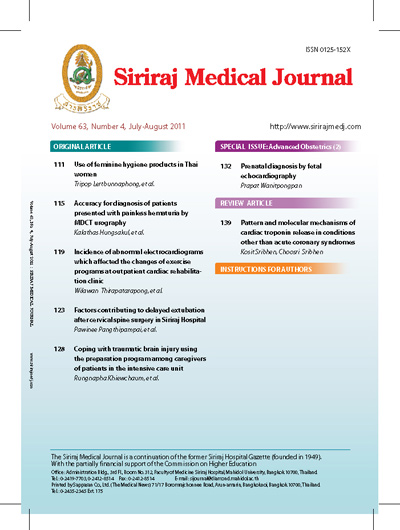Use of Feminine Hygiene Products in Thai Women
Keywords:
Feminine hygiene products; feminine wash; vaginal doucheAbstract
Objective: To determine the prevalence and explore the knowledge, attitude and practice of using feminine hygiene products in Thai women.
Methods: A survey was conducted between May and August 2009 in 400 Thai women between the ages of 20-35 who attended at Siriraj Gynecological clinic. Questionnaires dealing with knowledge, attitudes and practice were completed and data were collected and analyzed.
Results: The mean age of participants was 28.5 ± 4.2 years. The prevalence of participants who have ever used feminine wash and vaginal douche were 70.5% and 14.25%, respectively. To get rid of an unpleasant odor, and feeling clean and fresh were the most common reasons for using both products. The most common timing of using feminine wash was after period,
after bath and when having unpleasant odor, whereas having leucorrhea and unpleasant odor were noted in vaginal douche group. Significant association between use of vaginal douche and an experience of sexual intercourse was observed (P < 0.05).
Conclusion: Use of feminine hygiene products, especially feminine wash, was quite popular in Thai women. To get rid of unpleasant odor as well as to feel clean and fresh were common reasons for using this product. Recommendations by gynecologists about appropriate use of feminine hygiene products should be carefully considered in daily practice.
References
women douche? Results from a qualitative study. Matern Child Health
J. 2001 Sep;5(3):153-60.
2. Oh MK, Merchant JS, Brown P. Douching behavior in high-risk adolescents.
What do they use, when and why do they douche? J Pediatr
Adolesc Gynecol. 2002 Apr;15(2):83-8.
3. Grimley DM, Annang L, Foushee HR, Bruce FC, Kendrick JS. Vaginal
douches and other feminine hygiene products: women’s practices and
perceptions of product safety. Matern Child Health J. 2006 May;10(3):303-
10.
4. Farage M, Bramante M, Otaka Y, Sobel J. Do panty liners promote
vulvovaginal candidiasis or urinary tract infections? A review of the
scientific evidence. Eur J Obstet Gynecol Reprod Biol. 2007 May;132(1):
8-19.
5. Cottrell BH. An updated review of evidence to discourage douching.
MCN Am J Matern Child Nurs. 2010 Mar-Apr;35(2):102-7.
6. Czerwinski BS. Variation in feminine hygiene practices as a function of
age. J Obstet Gynecol Neonatal Nurs. 2000;29:625-33.
7. Ege E, Timur S, Zincir H, Egri M, Sunar Reeder B. Women’s douching
practices and related attitudes in eastern Turkey. J Obstet Gynecol Neonatal
Nurs. 2000 Nov-Dec;29(6):625-33.
8. Hacialioglu N, Nazik E, Kilic M. A descriptive study of douching practices
in Turkish women. Int J Nurs Pract. 2009 Apr;15(2):57-64.
9. Cottrell BH. Vaginal douching. J Obstet Gynecol Neonatal Nurs. 2003
Jan-Feb;32(1):12-8.
10. Simpson T, Merchant J, Grimley DM, Oh MK. Vaginal douching among
adolescent and young women: more challenges than progress. J Pediatr
Adolesc Gynecol. 2004 Aug;17(4):249-55.
11. Cottrell BH. Vaginal douching practices of women in eight Florida panhandle
counties. J Obstet Gynecol Neonatal Nurs. 2006 Jan-Feb;35(1):
24-33.
12. Luong ML, Libman M, Dahhou M, Chen MF, Kahn SR, Goulet L, et al.
Vaginal douching, bacterial vaginosis, and spontaneous preterm birth. J
Obstet Gynaecol Can. 2010 Apr;32(4):313-20.
13. Tansupasiri A, Puangsricharern A, Itti-arwachakul A, Asavapiriyanont S.
Satisfaction and tolerability of combination of lactoserum and lactic acid
on the external genitalia in Thai women. J Obstet Gynaecol Can. 2010
Apr;32(4):313-20.
Downloads
Published
How to Cite
Issue
Section
License
Authors who publish with this journal agree to the following conditions:
Copyright Transfer
In submitting a manuscript, the authors acknowledge that the work will become the copyrighted property of Siriraj Medical Journal upon publication.
License
Articles are licensed under a Creative Commons Attribution-NonCommercial-NoDerivatives 4.0 International License (CC BY-NC-ND 4.0). This license allows for the sharing of the work for non-commercial purposes with proper attribution to the authors and the journal. However, it does not permit modifications or the creation of derivative works.
Sharing and Access
Authors are encouraged to share their article on their personal or institutional websites and through other non-commercial platforms. Doing so can increase readership and citations.











